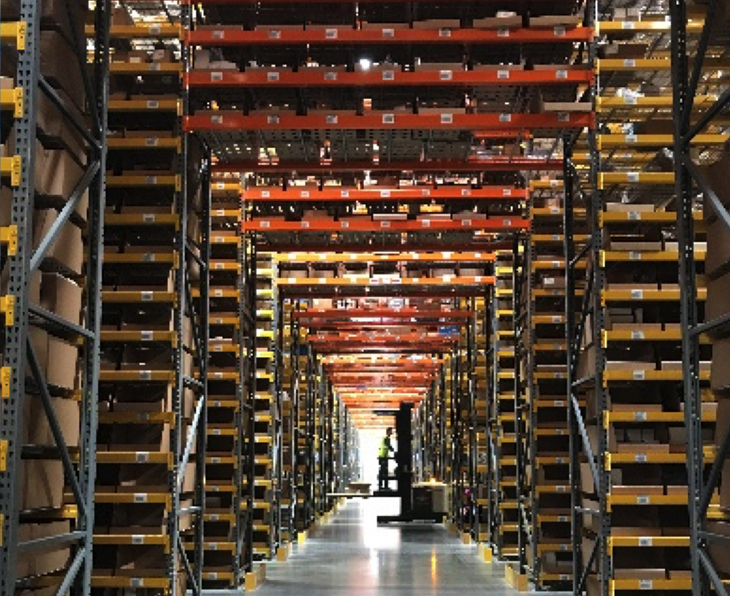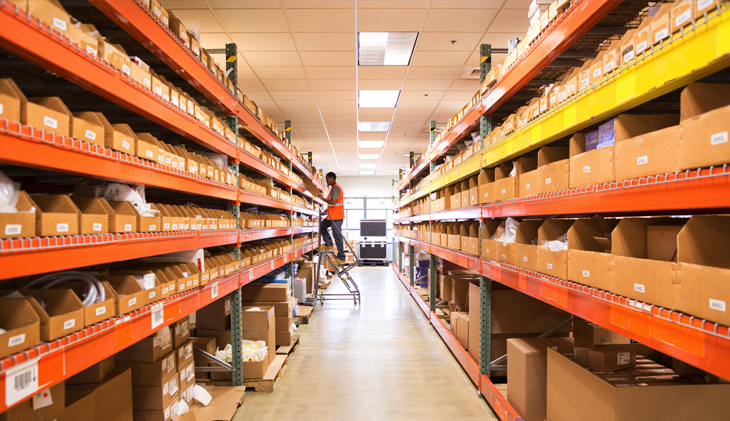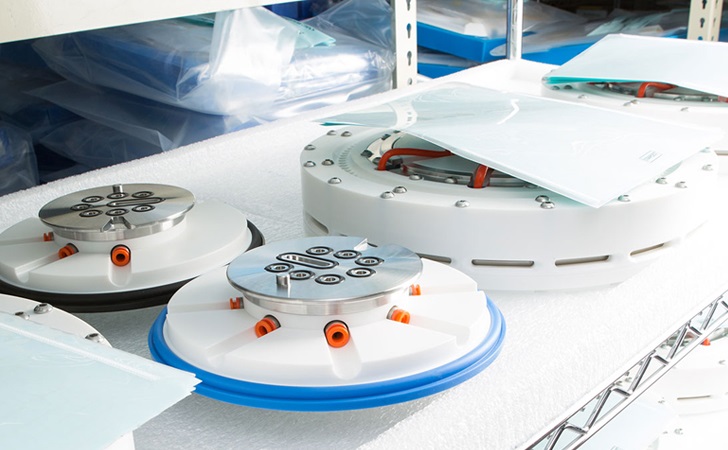Products & Technologies
Back to Menu
Products & Technologies
Services
Resources
Building a Sustainable Supply Chain for a Better Future
By Gary Dagastine

Applied Materials’ efforts to build a robust and sustainable supply chain for semiconductor and display manufacturing received increased focus earlier this year when the company announced its Supply Chain Certification for Environmental and Social Sustainability initiative (SuCCESS2030). The initiative’s goals are to reduce energy usage and emissions and conserve resources throughout the supply chain while meeting customer requirements globally, even in the face of unprecedented events such as the COVID-19 pandemic.
To accomplish these goals, Applied is optimizing its materials and parts selection, procurement, packaging, warehousing, transportation and recycling practices.
Bob Davis is Applied’s Corporate Vice President of AGS Operations and Component Engineering and Display Flexible Technology, responsible for supply chain performance. Nanochip Fab Solutions (NFS) spoke with him recently to learn about the need for a more sustainable supply chain, the steps Applied is taking to achieve that goal, notable successes to date, and relevant lessons learned from helping customers maintain production while the COVID-19 pandemic has raged.
NFS: Bob, why is building a more sustainable supply chain such a timely and important issue?
Davis: The need for a robust supply chain that incorporates environmental, social and governance (ESG) criteria has never been greater, for many reasons. From the customer perspective, the expectation is that we will do whatever is required to get them the parts and supplies they need whenever and wherever they are needed, even during unexpected, challenging and constantly changing conditions, such as we’ve experienced this year.
From an environmental perspective, the world clearly faces many challenges and we want to be part of the solution, not part of the problem. So when it comes to things like repairing, refurbishing and reusing parts instead of using the world’s scarce resources to produce brand-new ones, or using energy more wisely and thereby reducing carbon emissions, or reducing the amount of waste generated throughout our supply chain, we are striving to be a leader and a role model.

From a corporate governance perspective, there is a strong and growing preference on the part of employees, customers, partners, investors and governments to engage with corporations that incorporate sustainability practices in their operations.
NFS: Does this conflict with normal business practices? It sounds like a significant retooling of traditional operations.
Davis: What we’re doing is good business for Applied Materials. For example, as a general rule the fewer times and the less distance you have to move a product to get it from Point A to Point B, the greater your energy savings will be and the lower your costs. Accordingly, one of our major goals is to minimize unnecessary stops and transfers as parts and supplies move around the world, and to build in flexibility as to how we do that to lower our carbon footprint and reduce costs while still meeting customer needs.

One example is our implementation of a multi-tiered warehousing strategy for spare parts. First, we have set up depots close to major customers, stocked with the parts our forecasts show they are likely going to need on a timely, ongoing basis. We have also established regional depots, serving specific countries and geographic areas, stocked with parts commonly used in those regions. Finally, we have three continental distribution centers, or CDCs, in Europe, Taiwan, and California, which have much more complete inventories of spare parts dedicated to those regions. This strategy enables us to shorten response times and reduce fuel use, carbon emissions and transportation costs, and gives us the flexibility to respond to changing conditions.
NFS: You mentioned parts reuse. Is that a major focus of your efforts?
Davis: We think it makes little sense to expend resources to build and ship a brand-new spare part when the part it would replace can be repaired and refurbished cost-effectively. For example, process power supplies, RF matching networks, and ceramic and metal wafer pedestals often lend themselves to repair and reuse, but they are just the tip of the iceberg. Our spare parts repair work has tripled in recent years, and a major goal is how to drive the repair percentage up still further.
We have an entire engineering team dedicated to identifying all parts that might possibly be suitable for repair and reuse. This team asks questions like: Can we repair this particular part adequately and cost-effectively? How many times can we repair it? Can we protect it via special packaging so that it can be moved safely? Can we design the packaging so that it can be reused as well? How can we do all of this in reasonably close proximity to the customer, and in an environmentally sustainable way?
These challenges are more complex than they might seem. For one thing, as the price of a spare part decreases, the economics of repair become challenging. Also, a part may need different

levels of repair at different points in its lifetime. At first, we might just rework the surface of a part, but after two or three reworkings we might have to do a more aggressive repair. Even with something as straightforward as a wafer pedestal, for example, temperature, chemical and plasma issues must be considered when determining whether repair is a viable option.
NFS: How do our suppliers feel about this movement toward repair and reuse?
Davis: It can help them in several ways. We may turn to the primary supplier of a given part and ask them to do the refurbishments we’ve identified, which is additional business for them. Our engineers also provide feedback to our suppliers on how the parts performed in actual use on the factory floor, which enables suppliers to make improvements for longer lifetimes, better performance and/or ease of repair.

In other cases, given the growth of the semiconductor industry in recent years, there are some suppliers who cannot keep up with demand for new parts. Much of the issue goes to specific components. During the repair, we reuse many of the original components in the rebuild. This frequently reduces the bottleneck on key components, which allows suppliers to build sufficient new parts while dedicating some capacity to repair.
NFS: We’ve all heard the saying that necessity is the mother of invention. Has having to deal with the COVID-19 pandemic aided your efforts to develop a sustainable supply chain?
Davis: The pandemic has opened our eyes to the supply chain challenges that really exist out there. I like to say that before the pandemic our imagination of what could go wrong was insufficient, because we focused our contingency planning primarily on the possibility of earthquakes occurring in key areas like Japan, Taiwan and Northern California.
But in early January we became aware that earthquakes weren’t the only problem. Instead, a pandemic was on the rise and migrating around the world, and so we began to look urgently at what parts might be needed by our customers and how we could get them produced and stocked to meet the looming crisis. We used proprietary analytics in our planning to avoid running out of spare parts and to respond to the many issues that arose, which aided us immensely.
Adding to the difficulty of ensuring continuity in our supply chain was the fact that Santa Clara County in California, where we are headquartered, was perhaps the first county in the United States to order residents to shelter-in-place. As a semiconductor business we could stay open, with most Applied employees, including me, working from home. But that order had a dramatic effect on our supply base. I’m proud to say that thanks to our incredibly smart and hardworking people and partners we didn’t miss a beat. But those efforts did drive up our costs.

A key issue was that transportation capacity was down. Prior to the pandemic, we often transported spare parts as economic “belly cargo” in commercial aircraft; that is, in the hold at the bottom of a plane. But as the global response to the pandemic increased, far fewer planes were flying and those that were, were smaller with less cargo space. So we turned to commercial delivery services like UPS, FedEx, DHL and others that were adding capacity. But as it turned out, we were competing for space there against the personal protective gear that was being shipped around the world at the time.
Meanwhile, moving physically large equipment had its own challenges. Our people were literally tracking the movement of cargo ships to better understand when equipment that was in transit would arrive, and so again, we continued to meet our customer demand.
NFS: What are the main lessons for supply chain sustainability that you learned from these unprecedented challenges?
Davis: First, the fewer parts coming from just one location, the better, and while supporting more suppliers in more locations to provide more repair options is costly, we do need the flexibility

Second, the movement of the virus around the world taught us that we need to be prepared to initiate a rolling response as conditions warrant. When our repair center in Malaysia was completely shut down we shifted the work to our facility in Taiwan, and then subsequently back to Malaysia when they were able to reopen. We also made some other strategic movements to continue to deliver on time.
Third, establishing a buffer is key for certain types of products where lead times are longer and more complex.
Fourth, it’s important to find out where our suppliers actually do their work, which may or may not be at the location we assume, because it can introduce delivery-time uncertainty. For example, we have suppliers who receive purchase orders in one location but build the part elsewhere. In a pandemic that could impact our ability to get a part delivered in a timely way. And finally, we have to make sure key suppliers have their own business continuity plans. Larger suppliers are more likely to have such plans, and we sometimes help key smaller suppliers develop them.
And finally, we have to make sure key suppliers have their own business continuity plans. Larger suppliers are more likely to have such plans, and we sometimes help key smaller suppliers develop them.

NFS: Any final comments, Bob?
Davis: This has been a year of exceptional challenges. Even while the COVID-19 pandemic disrupted industries and supply chains everywhere, we intensified our efforts to find new, more sustainable ways to supply customers going forward. The lessons learned will carry us into the future and help us, our customers and the world around us in future years.
Change is nothing new, of course. What matters is our collective response to it, and nothing we have accomplished this year would have been possible without the talent, hard work and resiliency of our people, our customers and our suppliers. I’m very proud of our collective response.

Bob Davis is Corporate Vice President of AGS Operations and Component Engineering and Display Flexible Technology at Applied Materials.
For additional information, contact him at bob_davis@amat.com.
